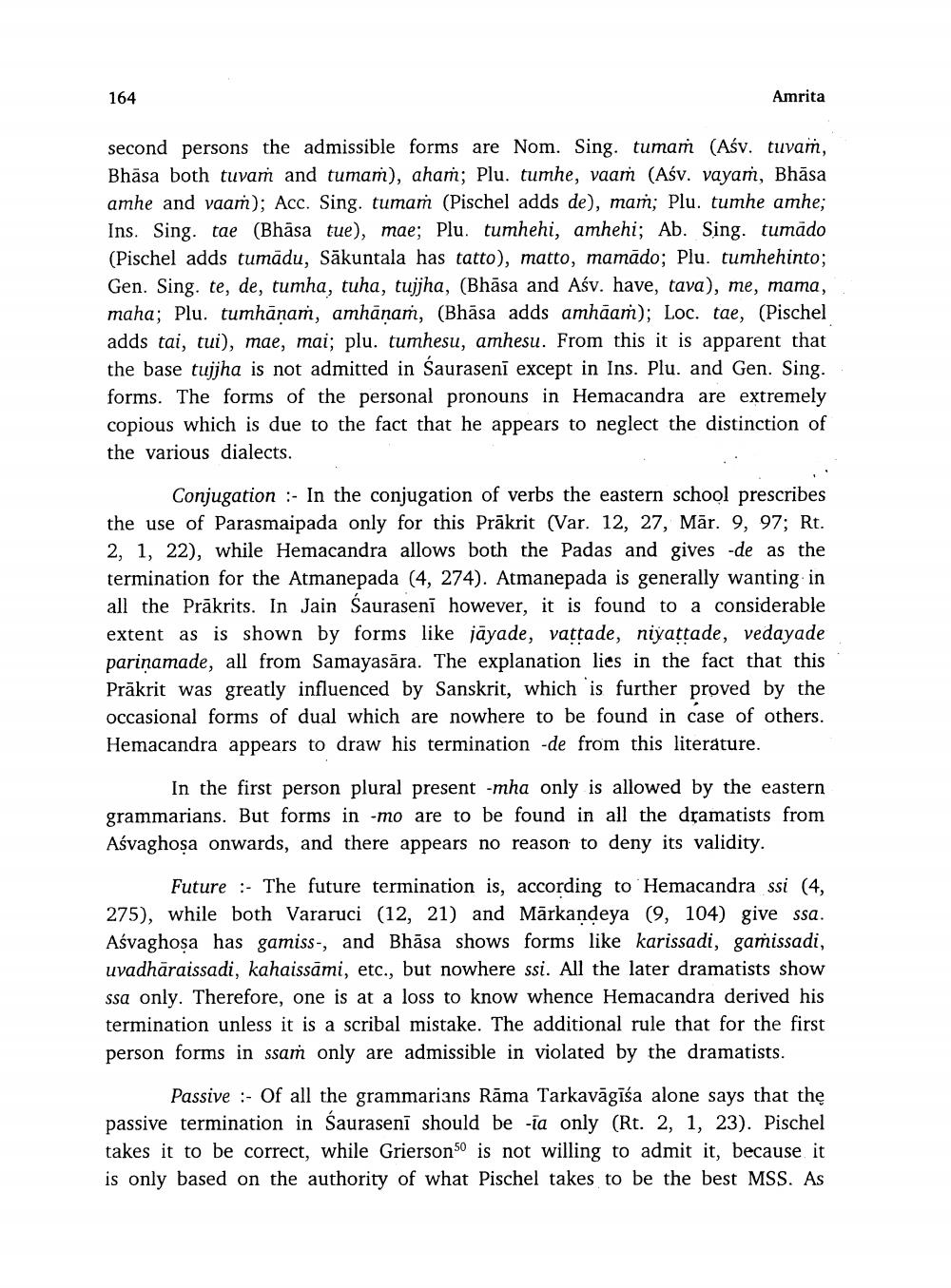________________
164
Amrita
second persons the admissible forms are Nom. Sing. tumam (Aśv. tuvas, Bhāsa both tuvam and tumam), aham; Plu. tumhe, vaaṁ (Asv. vayam, Bhāsa amhe and vaam); Acc. Sing. tumam (Pischel adds de), mam; Plu. tumhe amhe; Ins. Sing. tae (Bhāsa tue), mae; Plu. tumhehi, amhehi; Ab. Sing. tumādo (Pischel adds tumādu, Sākuntala has tatto), matto, mamādo; Plu. tumhehinto; Gen. Sing. te, de, tumha, tuha, tujjha, (Bhāsa and Aśv. have, tava), me, mama, maha; Plu. tumhānam, amhānań, (Bhāsa adds amhāam); Loc. tae, (Pischel adds tai, tui), mae, mai; plu. tumhesu, amhesu. From this it is apparent that the base tujha is not admitted in Saurasenī except in Ins. Plu. and Gen. Sing. forms. The forms of the personal pronouns in Hemacandra are extremely copious which is due to the fact that he appears to neglect the distinction of the various dialects.
Conjugation :- In the conjugation of verbs the eastern school prescribes the use of Parasmaipada only for this Prākrit (Var. 12, 27, Mār. 9, 97; Rt. 2, 1, 22), while Hemacandra allows both the Padas and gives -de as the termination for the Atmanepada (4, 274). Atmanepada is generally wanting in all the Prākrits. In Jain Saurasenī however, it is found to a considerable extent as is shown by forms like jayade, vattade, niyattade, vedayade parinamade, all from Samayasāra. The explanation lies in the fact that this Prākrit was greatly influenced by Sanskrit, which is further proved by the occasional forms of dual which are nowhere to be found in case of others. Hemacandra appears to draw his termination -de from this literature.
In the first person plural present -mha only is allowed by the eastern grammarians. But forms in .mo are to be found in all the dramatists from Aśvaghosa onwards, and there appears no reason to deny its validity.
Future :- The future termination is, according to Hemacandra ssi (4, 275), while both Vararuci (12, 21) and Mārkandeya (9, 104) give ssa. Aśvaghosa has gamiss-, and Bhāsa shows forms like karissadi, gamissadi, uvadhāraissadi, kahaissāmi, etc., but nowhere ssi. All the later dramatists show ssa only. Therefore, one is at a loss to know whence Hemacandra derived his termination unless it is a scribal mistake. The additional rule that for the first person forms in ssaṁ only are admissible in violated by the dramatists.
Passive :- Of all the grammarians Rāma Tarkavāgāśa alone says that the passive termination in Saurasenī should be -ia only (Rt. 2, 1, 23). Pischel takes it to be correct, while Grierson 50 is not willing to admit it, because it is only based on the authority of what Pischel takes to be the best MSS. As




